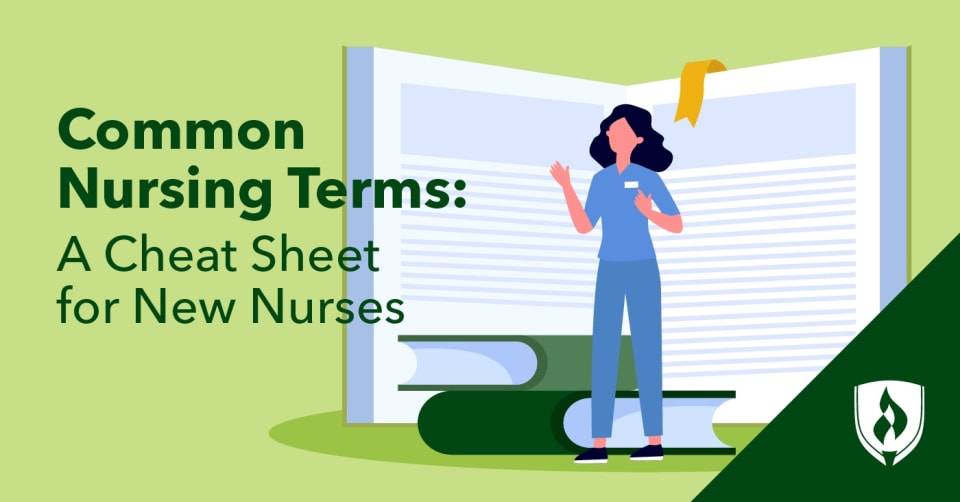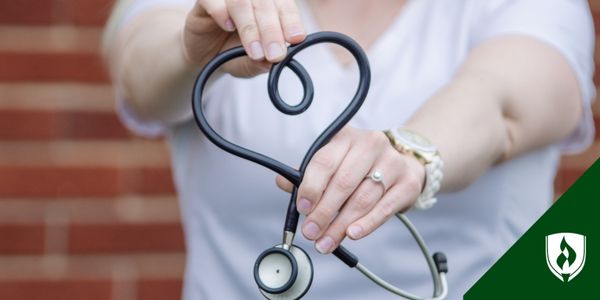
You have your sights set on nursing school, but you’re concerned you won’t be able to keep up with all the need-to-know nursing terms. Even years of watching TV medical dramas isn’t making you feel more confident in your knowledge of medical vocabulary. Every career field has its own lingo that can sound like complete nonsense to the uninitiated, and the nursing field is certainly not the exception.
There’s enough to think about before starting your first day of nursing school—even without mysterious jargon to worry about! Keep this cheat sheet of the most common nursing terms handy as you study, and you’ll never again be lost in a blur of meaningless acronyms and confusing medical terms.
62 Common nursing terms you should know
General nursing terms
- Blood pressure (BP): Blood pressure measures the amount of force placed on a patient’s artery walls with each heartbeat. This is one of the standard vital signs nurses monitor for patients.
- Charge nurse: A supervisory nurse who oversees other nurses in a particular hospital department.
- Chart: The medical documentation that follows a patient throughout a healthcare facility. It includes medical history, diagnoses, test results, dosage and timing of medications, and other relevant information.
- Charting: The process of adding to a patient’s chart to keep it up to date and accurate. Nurses often use medical acronyms and abbreviations in their chartings.
- Clinicals: The portion of nursing education where student nurses work with patients in a healthcare setting, under supervision from nurses and physicians, to practice their technical skills and gain experiences.
- Code blue: A medical emergency, often cardiac arrest, that requires immediate attention from a team of healthcare providers. Healthcare workers may shorten code blue to “coding.”
- Heart rate: The number of heartbeats a patient has per minute.
- NCLEX: Refers to the nursing exam one must pass to become either a licensed practical nurse (LPN) or a registered nurse (RN).
- Pain scale: A numeric scale from one to ten that patients use to rate their level of pain. Some healthcare facilities use visual cues like faces to help patients rate their pain levels.
- Respiratory rate: The number of breaths a patient takes per minute.
- Specimen: A sample of something from a patient’s body, such as urine, blood, skin or other tissue, that is taken for testing and analysis.
- Vital signs: Basic indicators of a patient’s health that typically includes heart rate, respiratory rate, body temperature, pain level and blood pressure.
Terms for nursing specialties
- Cardiac nursing: A nursing specialty centered around the cardiovascular system (the heart and blood circulation system).
- Dialysis nursing: A nursing specialty that focuses on patients who have kidney disease, are experiencing kidney failure or are undergoing dialysis treatments.
- Home health nursing: Nurses who visit patients in their own homes to provide care.
- ICU nurse: Nurses who work in the intensive care unit (ICU), typically caring for just one or two patients with severe injuries or ailments at a time.
- Nurse anesthetist: Nurse anesthetists who administer anesthesia and pain management medication to patients. This role requires specialized advanced training.
- Nursing informatics: Nursing informatics who combine practical nursing skills with data analysis and technology to improve patient safety.
- Oncology nursing:Nurses who care for cancer patients and those being screened for cancer diagnoses.
- Radiology nursing: Nurses who care for patients who are undergoing diagnostic imaging, such as CT scans, X-rays and ultrasounds.
Nursing acronyms
- ABC: This is the simple way to remember “airway, breathing, circulation,” which is the order in which nurses assess and prioritize a patient who is unresponsive or unconscious.
- CAB: Following the CAB acronym helps nurses remember “chest compressions, airway and breathing” as the correct order for performing CPR.
- CBR: Seeing this on a patient’s chart means “complete bed rest” and refers to a patient who is not allowed out of bed at all, even to use the bathroom.
- CPR: Cardiopulmonary resuscitation is an emergency procedure commonly used when a patient has stopped breathing.
- DNR: Do Not Resuscitate is an end-of-life health directive given by patients who do not wish to be revived if they stop breathing or go into cardiac arrest.
- EHR: Electronic health records (sometimes called electronic medical records, or EMR) are digital medical records that are updated each time a patient visits a healthcare facility.
- ICU: Intensive care unit.
- IV: Intravenous therapy.
- L&D: Labor and delivery.
- NICU: Neonatal intensive care unit, where critically ill newborns are cared for.
- OTC: Medication that does not require a prescription (over the counter).
- PPE: Specialized gear and clothing, such as gloves, masks and face shields, designed to protect both patients and nurses from bacteria and contagious illness (personal protective equipment).
- Rx: Prescription.
- SOP: Standard operating procedures, which describe how nursing tasks are to be performed and the outcome that should be achieved.
- WNL: This charting acronym stands for “within normal limit.” This means a patient’s activity level, test results and so on are considered typical.
Nursing designations and degrees
- ADN: Associate’s Degree in Nursing.
- APRN: This stands for “advanced practice registered nurse” and refers to nurses who have completed a specialized graduate degree program. In addition to the usual duties of an RN, they can also diagnose and treat patients and choose to practice certain specialties, such as nurse anesthetist.
- BSN: Bachelor of Science in Nursing.
- CNA: Certified nursing assistants are not technically nurses, but they do help patients with basic tasks, like bathing and dressing. They may also take vital signs.
- LPN: Stands for licensed practical nurses. They have a narrower scope of practice than registered nurses but are tasked with a wide variety of nursing duties, such as changing bandages, administering medication, monitoring vital signs and inserting catheters.
- MSN: Master of Science in Nursing.
- RN: This acronym stands for “registered nurse” and refers to a nurse who has passed the NCLEX-RN exam and is fully licensed in their state.
Common medical tests and procedures
- Basic metabolic panel: Sometimes shortened to BMP, this refers to a routine blood test that measures basic body functions, like kidney effectiveness and sugar levels.
- CT scan: An imaging procedure that uses X-rays and computer technology to produce highly detailed images.
- EKG: A test that checks for signs of heart disease (electrocardiogram).
- IV therapy: An IV is used to deliver fluid, such as medication or rehydration fluids, directly into a patient’s veins.
- Saline lock: A medical procedure in which an IV catheter is placed in a patient’s vein, then flushed with saline solution and “locked” without additional fluids or medications. Saline locks make it easy for nurses to quickly administer IV medications during a patient’s hospital stay.
- Spinal tap: Also called a lumbar puncture, this is a procedure that uses a needle to remove fluid from a patient’s spinal column for diagnostic purposes.
- Ultrasound: An imaging procedure that uses high-frequency sound waves.
- Urinalysis: A common urine test that can detect and diagnose a variety of illnesses, such as urinary tract infections, or access kidney function.
- Vaccination: A minor medical procedure that reduces the risk of contracting and spreading contagious illnesses.
- X-ray: An imaging procedure that uses electromagnetic waves, which is a type of radiation.
Nursing tools
- Catheter: Any flexible, hollow tube used in medical procedures; most often refers to a tube used to drain urine from the bladder.
- Pulse oximeter: A small device that clips to a patient’s finger or toe to measure the amount of oxygen in their blood. Nurses can often use a pulse oximeter to determine which patients need to take priority in an emergency department setting.
- Sharps container: A hard plastic container used as a trash receptacle for any type of biomedical waste—anything that’s been used to puncture human skin—such as needles or IV catheters.
- Stethoscope: An audio device that allows nurses to hear a patient’s pulse or take their blood pressure.
- Tourniquet: A tight band used to control bleeding after an injury, surgery or other medical procedure.
Slang
- Crash cart: A wheeled cart with all the medications and supplies necessary to save someone in cardiac arrest or experiencing other life-threatening emergencies.
- Peds: Pronounced “peeds,” this term is short for “pediatric,” or anything related to children.
- STAT: This term, short for the Latin statim, does in fact mean to do something urgently or immediately. However, you won’t hear it quite as often or as dramatically as TV dramas would have you believe.
- Sundowning: This refers to an observed pattern that often occurs in dementia patients around evening, when the sun is going down. During this time of day, “sundowners” can become especially confused, irritated or delusional.
- Tachy: Pronounced “tacky,” this term is slang for “tachycardia,” which means a patient has an increased heart rate.
Definitions to use in your nursing career
This handy list of nursing terms will help you stay in the know for nursing school and beyond. Now you have a basic understanding of common nursing vocabulary, but you’ll need more training than that to become a registered nurse! Choose the best education option for you by reading “How to Become an RN Fast: 3 Potential Paths to Pursue.”
Looking for more nursing student resources? Read on here.




